BUSM4689: The Political Economy of International Business in Australia
VerifiedAdded on 2023/01/20
|18
|5079
|73
Report
AI Summary
This report delves into the political economy of international business, focusing on the mining industry in Australia. It begins with an introduction to the mining sector's significance in the Australian economy, its contributions to employment, and its role as a major exporter of minerals. The report then applies the theory of Intra and Inter-organizational Networks to the mining industry, exploring the relationships between parent companies, subsidiaries, customers, suppliers, and government entities. The strengths of this theory, such as higher interdependence and profit potential, are discussed. The report further examines the structure of the mining industry, including Australia's position as a leading producer of minerals and its contributions to GDP. It also covers market orientation, ownership, financing, and government regulations. The report then discusses the future of the mining cycle, including the importance of recycling and responsible mining practices. Finally, it analyzes the historical context of the MNCs as Intra and Inter-organizational Networks theory and critiques the theory. The report highlights the importance of the theory in understanding the competitive advantages of MNCs and their relationships with stakeholders. Overall, the report provides a comprehensive overview of the political economy of the international mining business, providing a detailed analysis of the industry's key firms, industry structure, global production and marketing orientation, ownership and financing, and government regulations.
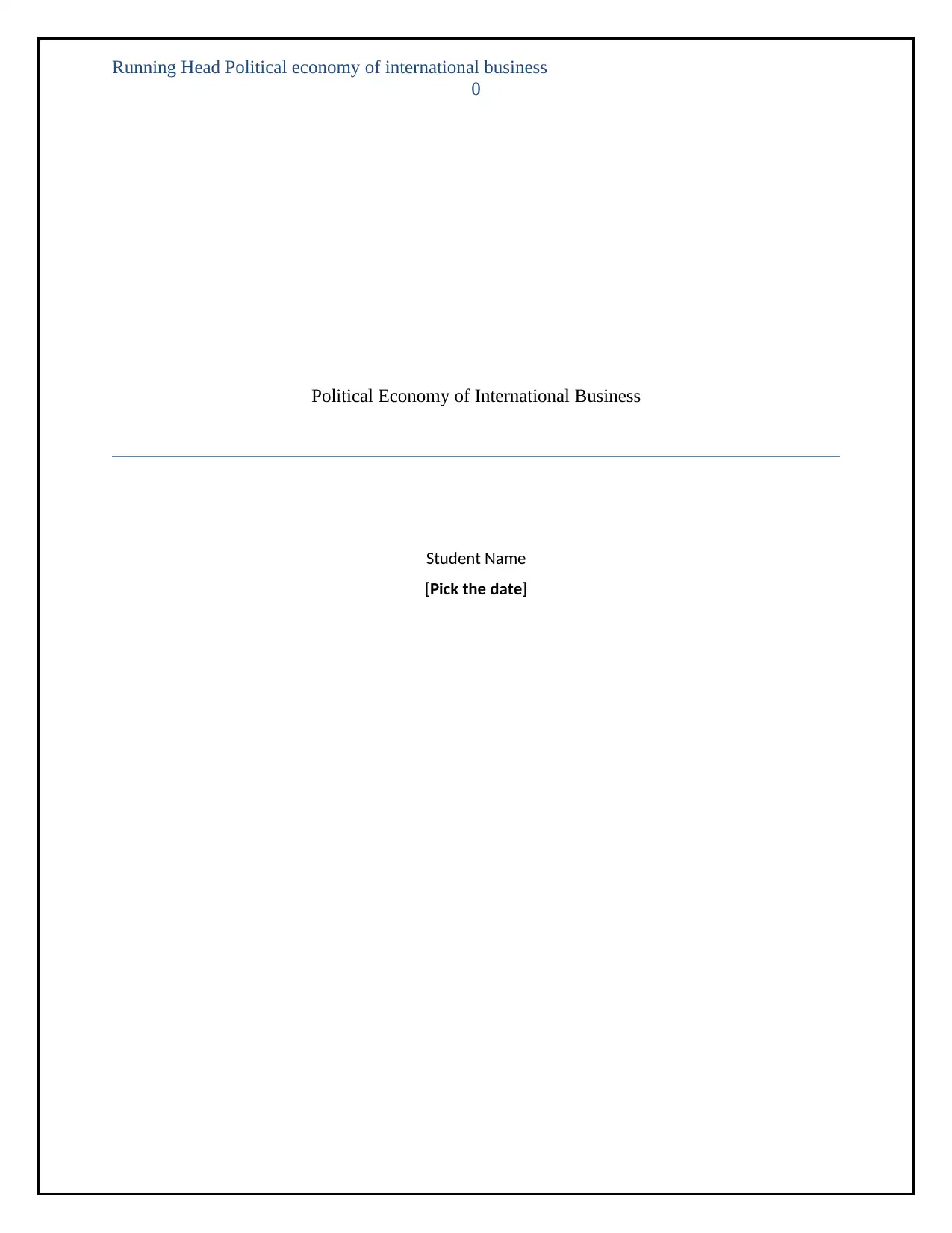
Running Head Political economy of international business
0
Political Economy of International Business
Student Name
[Pick the date]
0
Political Economy of International Business
Student Name
[Pick the date]
Paraphrase This Document
Need a fresh take? Get an instant paraphrase of this document with our AI Paraphraser
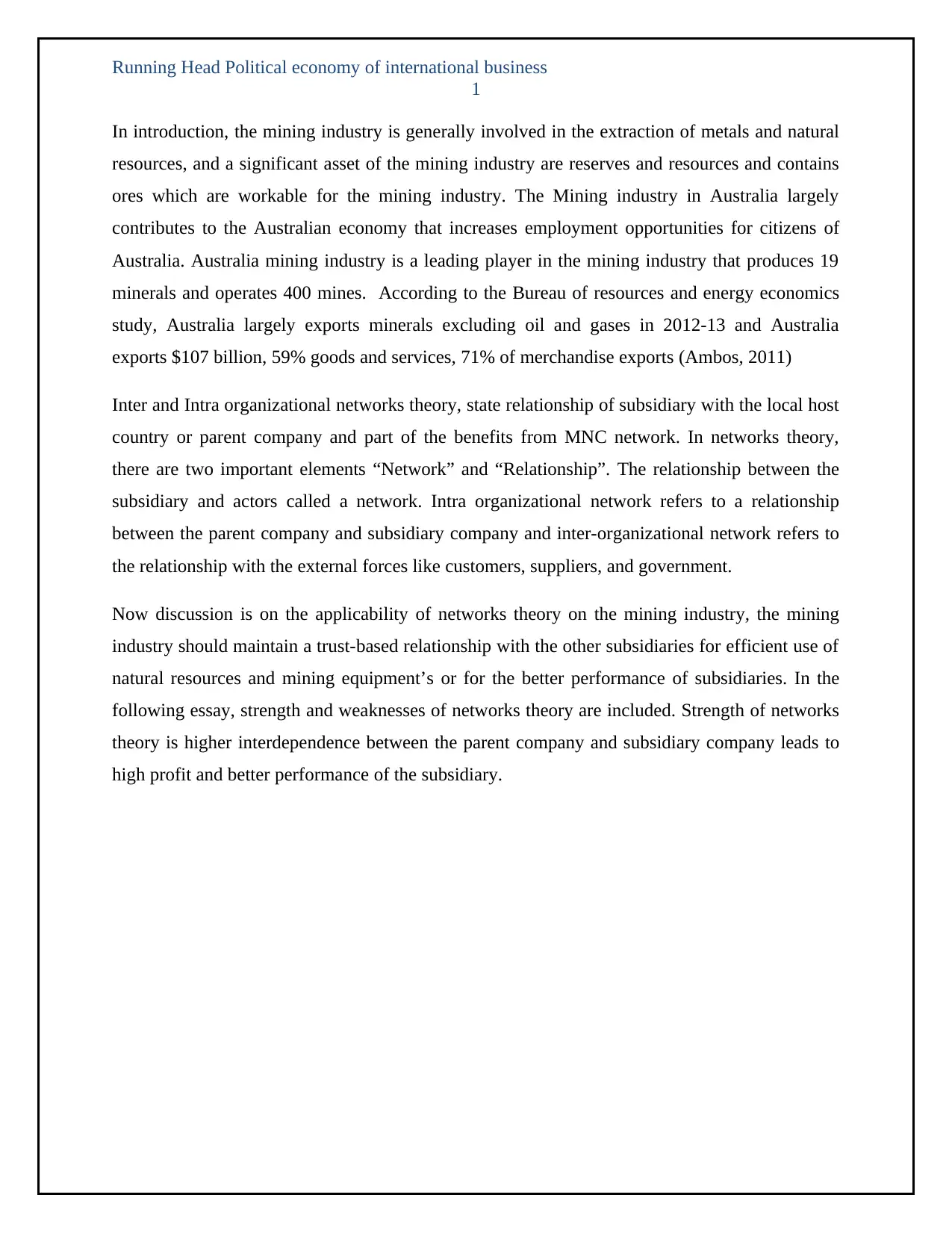
Running Head Political economy of international business
1
In introduction, the mining industry is generally involved in the extraction of metals and natural
resources, and a significant asset of the mining industry are reserves and resources and contains
ores which are workable for the mining industry. The Mining industry in Australia largely
contributes to the Australian economy that increases employment opportunities for citizens of
Australia. Australia mining industry is a leading player in the mining industry that produces 19
minerals and operates 400 mines. According to the Bureau of resources and energy economics
study, Australia largely exports minerals excluding oil and gases in 2012-13 and Australia
exports $107 billion, 59% goods and services, 71% of merchandise exports (Ambos, 2011)
Inter and Intra organizational networks theory, state relationship of subsidiary with the local host
country or parent company and part of the benefits from MNC network. In networks theory,
there are two important elements “Network” and “Relationship”. The relationship between the
subsidiary and actors called a network. Intra organizational network refers to a relationship
between the parent company and subsidiary company and inter-organizational network refers to
the relationship with the external forces like customers, suppliers, and government.
Now discussion is on the applicability of networks theory on the mining industry, the mining
industry should maintain a trust-based relationship with the other subsidiaries for efficient use of
natural resources and mining equipment’s or for the better performance of subsidiaries. In the
following essay, strength and weaknesses of networks theory are included. Strength of networks
theory is higher interdependence between the parent company and subsidiary company leads to
high profit and better performance of the subsidiary.
1
In introduction, the mining industry is generally involved in the extraction of metals and natural
resources, and a significant asset of the mining industry are reserves and resources and contains
ores which are workable for the mining industry. The Mining industry in Australia largely
contributes to the Australian economy that increases employment opportunities for citizens of
Australia. Australia mining industry is a leading player in the mining industry that produces 19
minerals and operates 400 mines. According to the Bureau of resources and energy economics
study, Australia largely exports minerals excluding oil and gases in 2012-13 and Australia
exports $107 billion, 59% goods and services, 71% of merchandise exports (Ambos, 2011)
Inter and Intra organizational networks theory, state relationship of subsidiary with the local host
country or parent company and part of the benefits from MNC network. In networks theory,
there are two important elements “Network” and “Relationship”. The relationship between the
subsidiary and actors called a network. Intra organizational network refers to a relationship
between the parent company and subsidiary company and inter-organizational network refers to
the relationship with the external forces like customers, suppliers, and government.
Now discussion is on the applicability of networks theory on the mining industry, the mining
industry should maintain a trust-based relationship with the other subsidiaries for efficient use of
natural resources and mining equipment’s or for the better performance of subsidiaries. In the
following essay, strength and weaknesses of networks theory are included. Strength of networks
theory is higher interdependence between the parent company and subsidiary company leads to
high profit and better performance of the subsidiary.
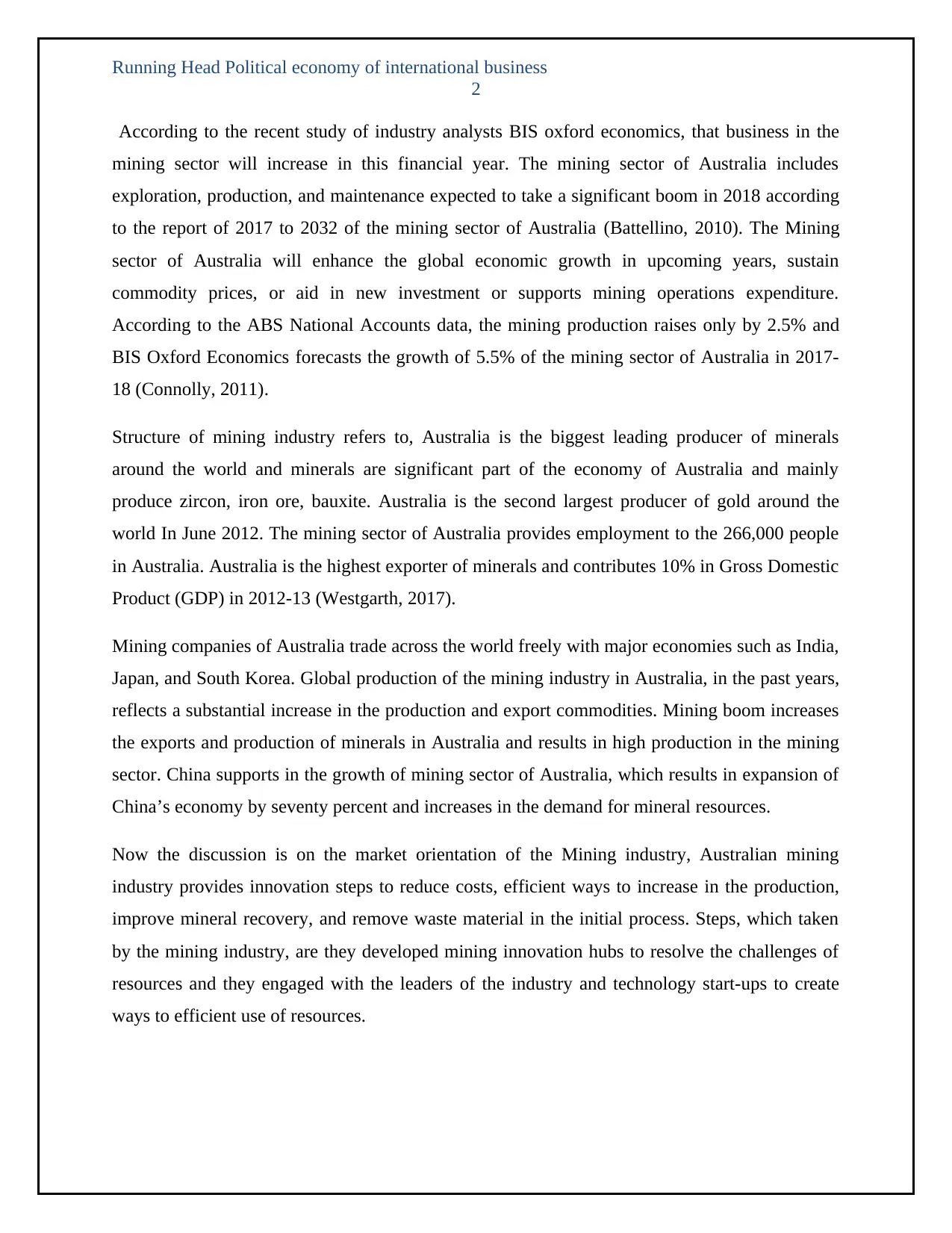
Running Head Political economy of international business
2
According to the recent study of industry analysts BIS oxford economics, that business in the
mining sector will increase in this financial year. The mining sector of Australia includes
exploration, production, and maintenance expected to take a significant boom in 2018 according
to the report of 2017 to 2032 of the mining sector of Australia (Battellino, 2010). The Mining
sector of Australia will enhance the global economic growth in upcoming years, sustain
commodity prices, or aid in new investment or supports mining operations expenditure.
According to the ABS National Accounts data, the mining production raises only by 2.5% and
BIS Oxford Economics forecasts the growth of 5.5% of the mining sector of Australia in 2017-
18 (Connolly, 2011).
Structure of mining industry refers to, Australia is the biggest leading producer of minerals
around the world and minerals are significant part of the economy of Australia and mainly
produce zircon, iron ore, bauxite. Australia is the second largest producer of gold around the
world In June 2012. The mining sector of Australia provides employment to the 266,000 people
in Australia. Australia is the highest exporter of minerals and contributes 10% in Gross Domestic
Product (GDP) in 2012-13 (Westgarth, 2017).
Mining companies of Australia trade across the world freely with major economies such as India,
Japan, and South Korea. Global production of the mining industry in Australia, in the past years,
reflects a substantial increase in the production and export commodities. Mining boom increases
the exports and production of minerals in Australia and results in high production in the mining
sector. China supports in the growth of mining sector of Australia, which results in expansion of
China’s economy by seventy percent and increases in the demand for mineral resources.
Now the discussion is on the market orientation of the Mining industry, Australian mining
industry provides innovation steps to reduce costs, efficient ways to increase in the production,
improve mineral recovery, and remove waste material in the initial process. Steps, which taken
by the mining industry, are they developed mining innovation hubs to resolve the challenges of
resources and they engaged with the leaders of the industry and technology start-ups to create
ways to efficient use of resources.
2
According to the recent study of industry analysts BIS oxford economics, that business in the
mining sector will increase in this financial year. The mining sector of Australia includes
exploration, production, and maintenance expected to take a significant boom in 2018 according
to the report of 2017 to 2032 of the mining sector of Australia (Battellino, 2010). The Mining
sector of Australia will enhance the global economic growth in upcoming years, sustain
commodity prices, or aid in new investment or supports mining operations expenditure.
According to the ABS National Accounts data, the mining production raises only by 2.5% and
BIS Oxford Economics forecasts the growth of 5.5% of the mining sector of Australia in 2017-
18 (Connolly, 2011).
Structure of mining industry refers to, Australia is the biggest leading producer of minerals
around the world and minerals are significant part of the economy of Australia and mainly
produce zircon, iron ore, bauxite. Australia is the second largest producer of gold around the
world In June 2012. The mining sector of Australia provides employment to the 266,000 people
in Australia. Australia is the highest exporter of minerals and contributes 10% in Gross Domestic
Product (GDP) in 2012-13 (Westgarth, 2017).
Mining companies of Australia trade across the world freely with major economies such as India,
Japan, and South Korea. Global production of the mining industry in Australia, in the past years,
reflects a substantial increase in the production and export commodities. Mining boom increases
the exports and production of minerals in Australia and results in high production in the mining
sector. China supports in the growth of mining sector of Australia, which results in expansion of
China’s economy by seventy percent and increases in the demand for mineral resources.
Now the discussion is on the market orientation of the Mining industry, Australian mining
industry provides innovation steps to reduce costs, efficient ways to increase in the production,
improve mineral recovery, and remove waste material in the initial process. Steps, which taken
by the mining industry, are they developed mining innovation hubs to resolve the challenges of
resources and they engaged with the leaders of the industry and technology start-ups to create
ways to efficient use of resources.
⊘ This is a preview!⊘
Do you want full access?
Subscribe today to unlock all pages.

Trusted by 1+ million students worldwide
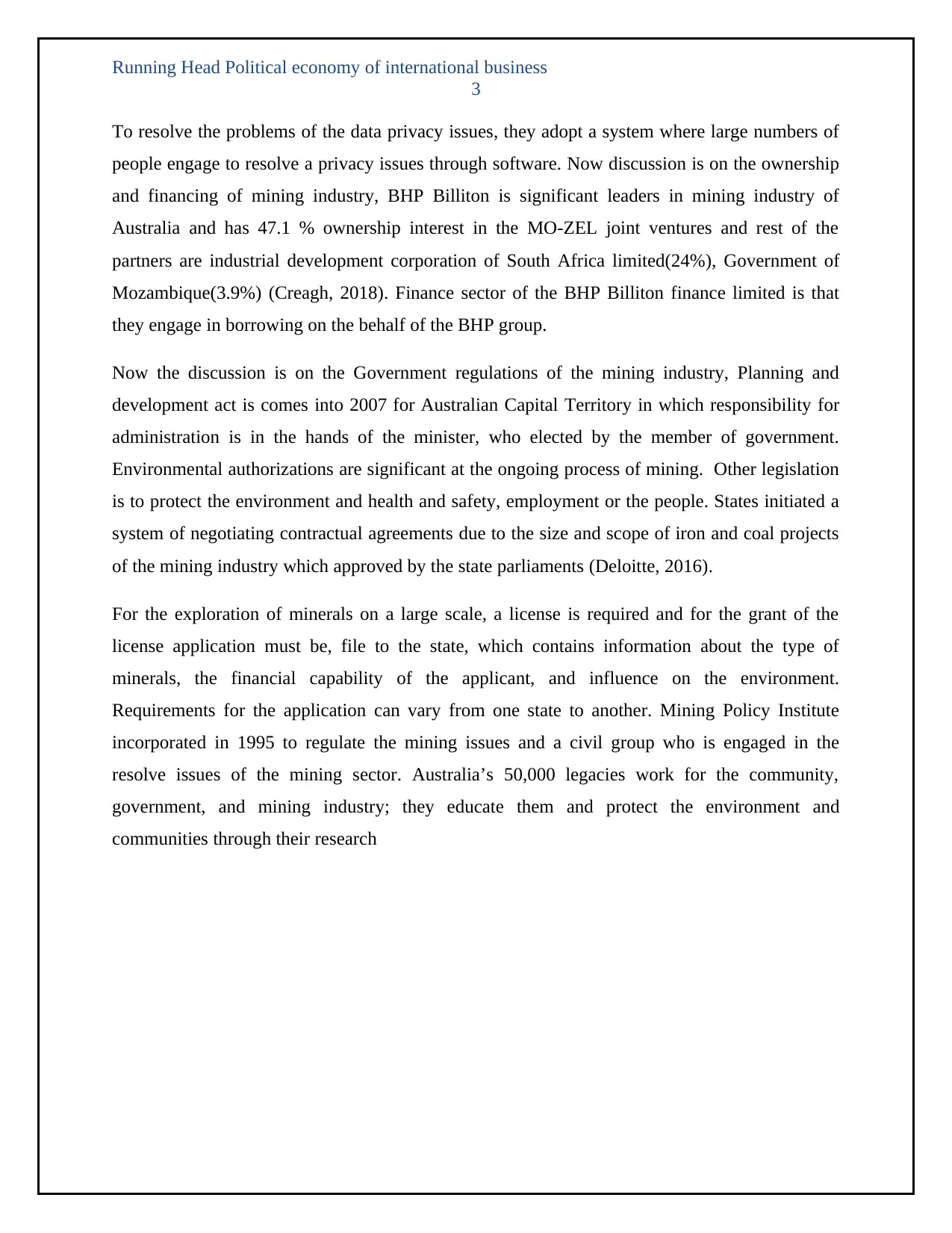
Running Head Political economy of international business
3
To resolve the problems of the data privacy issues, they adopt a system where large numbers of
people engage to resolve a privacy issues through software. Now discussion is on the ownership
and financing of mining industry, BHP Billiton is significant leaders in mining industry of
Australia and has 47.1 % ownership interest in the MO-ZEL joint ventures and rest of the
partners are industrial development corporation of South Africa limited(24%), Government of
Mozambique(3.9%) (Creagh, 2018). Finance sector of the BHP Billiton finance limited is that
they engage in borrowing on the behalf of the BHP group.
Now the discussion is on the Government regulations of the mining industry, Planning and
development act is comes into 2007 for Australian Capital Territory in which responsibility for
administration is in the hands of the minister, who elected by the member of government.
Environmental authorizations are significant at the ongoing process of mining. Other legislation
is to protect the environment and health and safety, employment or the people. States initiated a
system of negotiating contractual agreements due to the size and scope of iron and coal projects
of the mining industry which approved by the state parliaments (Deloitte, 2016).
For the exploration of minerals on a large scale, a license is required and for the grant of the
license application must be, file to the state, which contains information about the type of
minerals, the financial capability of the applicant, and influence on the environment.
Requirements for the application can vary from one state to another. Mining Policy Institute
incorporated in 1995 to regulate the mining issues and a civil group who is engaged in the
resolve issues of the mining sector. Australia’s 50,000 legacies work for the community,
government, and mining industry; they educate them and protect the environment and
communities through their research
3
To resolve the problems of the data privacy issues, they adopt a system where large numbers of
people engage to resolve a privacy issues through software. Now discussion is on the ownership
and financing of mining industry, BHP Billiton is significant leaders in mining industry of
Australia and has 47.1 % ownership interest in the MO-ZEL joint ventures and rest of the
partners are industrial development corporation of South Africa limited(24%), Government of
Mozambique(3.9%) (Creagh, 2018). Finance sector of the BHP Billiton finance limited is that
they engage in borrowing on the behalf of the BHP group.
Now the discussion is on the Government regulations of the mining industry, Planning and
development act is comes into 2007 for Australian Capital Territory in which responsibility for
administration is in the hands of the minister, who elected by the member of government.
Environmental authorizations are significant at the ongoing process of mining. Other legislation
is to protect the environment and health and safety, employment or the people. States initiated a
system of negotiating contractual agreements due to the size and scope of iron and coal projects
of the mining industry which approved by the state parliaments (Deloitte, 2016).
For the exploration of minerals on a large scale, a license is required and for the grant of the
license application must be, file to the state, which contains information about the type of
minerals, the financial capability of the applicant, and influence on the environment.
Requirements for the application can vary from one state to another. Mining Policy Institute
incorporated in 1995 to regulate the mining issues and a civil group who is engaged in the
resolve issues of the mining sector. Australia’s 50,000 legacies work for the community,
government, and mining industry; they educate them and protect the environment and
communities through their research
Paraphrase This Document
Need a fresh take? Get an instant paraphrase of this document with our AI Paraphraser
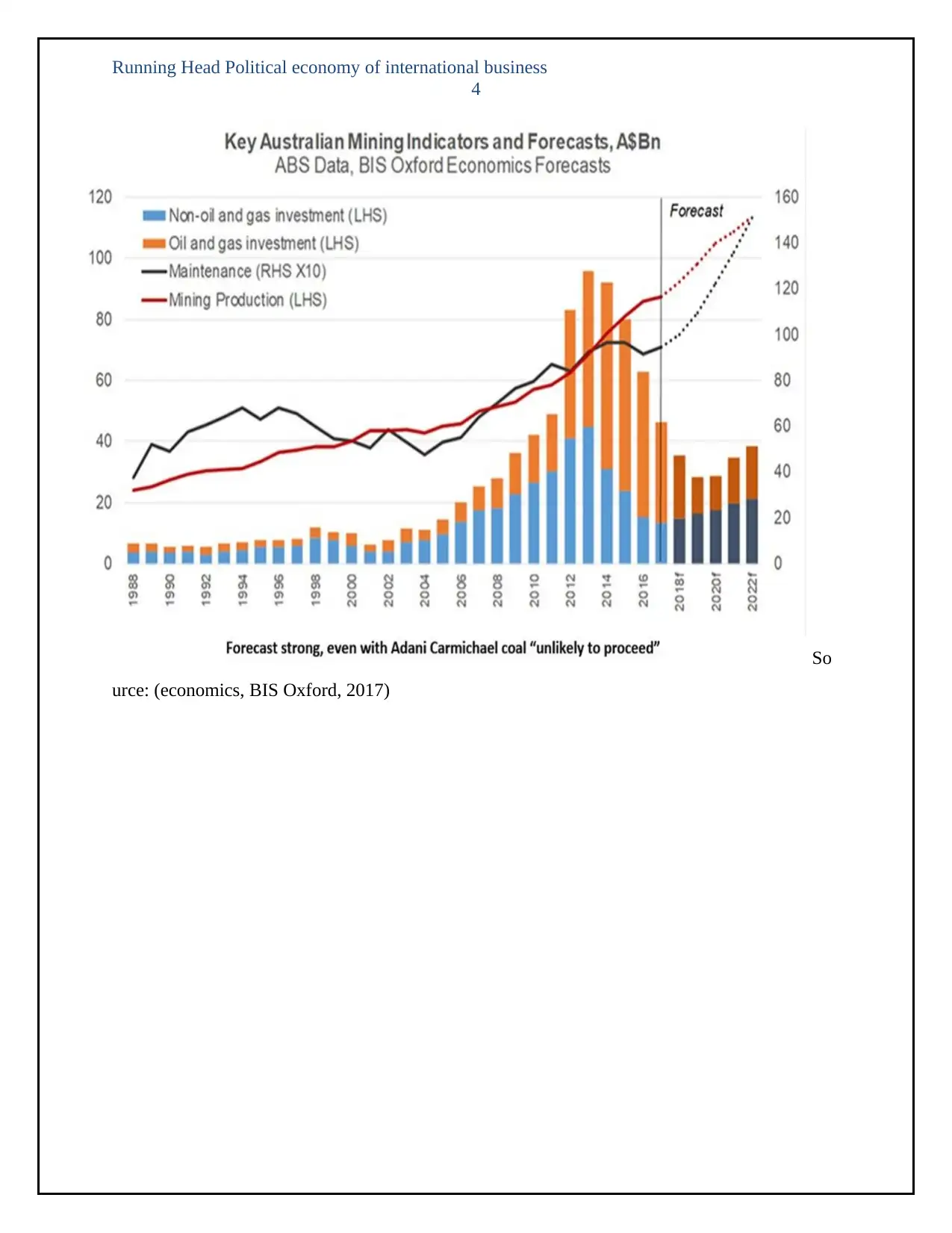
Running Head Political economy of international business
4
So
urce: (economics, BIS Oxford, 2017)
4
So
urce: (economics, BIS Oxford, 2017)
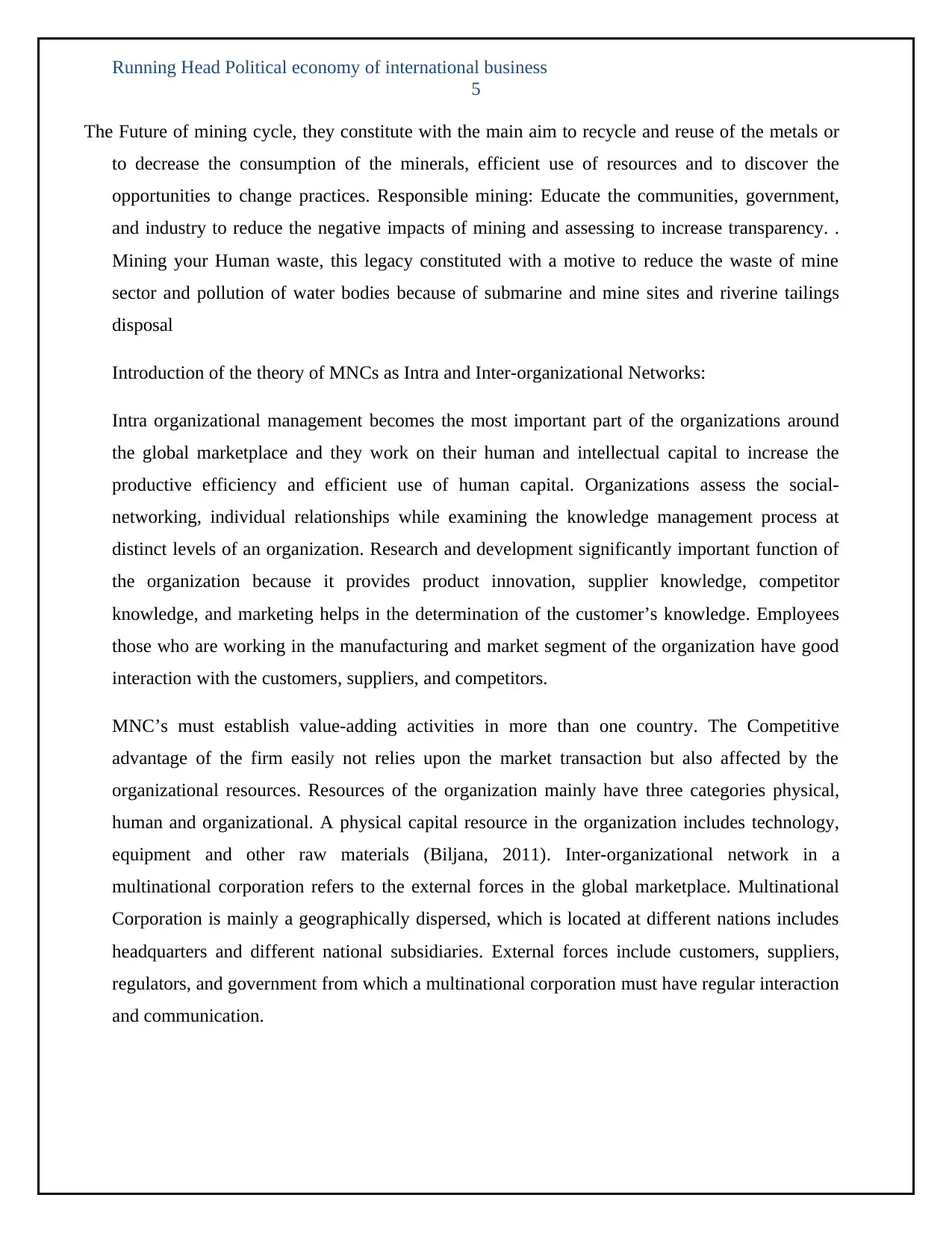
Running Head Political economy of international business
5
The Future of mining cycle, they constitute with the main aim to recycle and reuse of the metals or
to decrease the consumption of the minerals, efficient use of resources and to discover the
opportunities to change practices. Responsible mining: Educate the communities, government,
and industry to reduce the negative impacts of mining and assessing to increase transparency. .
Mining your Human waste, this legacy constituted with a motive to reduce the waste of mine
sector and pollution of water bodies because of submarine and mine sites and riverine tailings
disposal
Introduction of the theory of MNCs as Intra and Inter-organizational Networks:
Intra organizational management becomes the most important part of the organizations around
the global marketplace and they work on their human and intellectual capital to increase the
productive efficiency and efficient use of human capital. Organizations assess the social-
networking, individual relationships while examining the knowledge management process at
distinct levels of an organization. Research and development significantly important function of
the organization because it provides product innovation, supplier knowledge, competitor
knowledge, and marketing helps in the determination of the customer’s knowledge. Employees
those who are working in the manufacturing and market segment of the organization have good
interaction with the customers, suppliers, and competitors.
MNC’s must establish value-adding activities in more than one country. The Competitive
advantage of the firm easily not relies upon the market transaction but also affected by the
organizational resources. Resources of the organization mainly have three categories physical,
human and organizational. A physical capital resource in the organization includes technology,
equipment and other raw materials (Biljana, 2011). Inter-organizational network in a
multinational corporation refers to the external forces in the global marketplace. Multinational
Corporation is mainly a geographically dispersed, which is located at different nations includes
headquarters and different national subsidiaries. External forces include customers, suppliers,
regulators, and government from which a multinational corporation must have regular interaction
and communication.
5
The Future of mining cycle, they constitute with the main aim to recycle and reuse of the metals or
to decrease the consumption of the minerals, efficient use of resources and to discover the
opportunities to change practices. Responsible mining: Educate the communities, government,
and industry to reduce the negative impacts of mining and assessing to increase transparency. .
Mining your Human waste, this legacy constituted with a motive to reduce the waste of mine
sector and pollution of water bodies because of submarine and mine sites and riverine tailings
disposal
Introduction of the theory of MNCs as Intra and Inter-organizational Networks:
Intra organizational management becomes the most important part of the organizations around
the global marketplace and they work on their human and intellectual capital to increase the
productive efficiency and efficient use of human capital. Organizations assess the social-
networking, individual relationships while examining the knowledge management process at
distinct levels of an organization. Research and development significantly important function of
the organization because it provides product innovation, supplier knowledge, competitor
knowledge, and marketing helps in the determination of the customer’s knowledge. Employees
those who are working in the manufacturing and market segment of the organization have good
interaction with the customers, suppliers, and competitors.
MNC’s must establish value-adding activities in more than one country. The Competitive
advantage of the firm easily not relies upon the market transaction but also affected by the
organizational resources. Resources of the organization mainly have three categories physical,
human and organizational. A physical capital resource in the organization includes technology,
equipment and other raw materials (Biljana, 2011). Inter-organizational network in a
multinational corporation refers to the external forces in the global marketplace. Multinational
Corporation is mainly a geographically dispersed, which is located at different nations includes
headquarters and different national subsidiaries. External forces include customers, suppliers,
regulators, and government from which a multinational corporation must have regular interaction
and communication.
⊘ This is a preview!⊘
Do you want full access?
Subscribe today to unlock all pages.

Trusted by 1+ million students worldwide
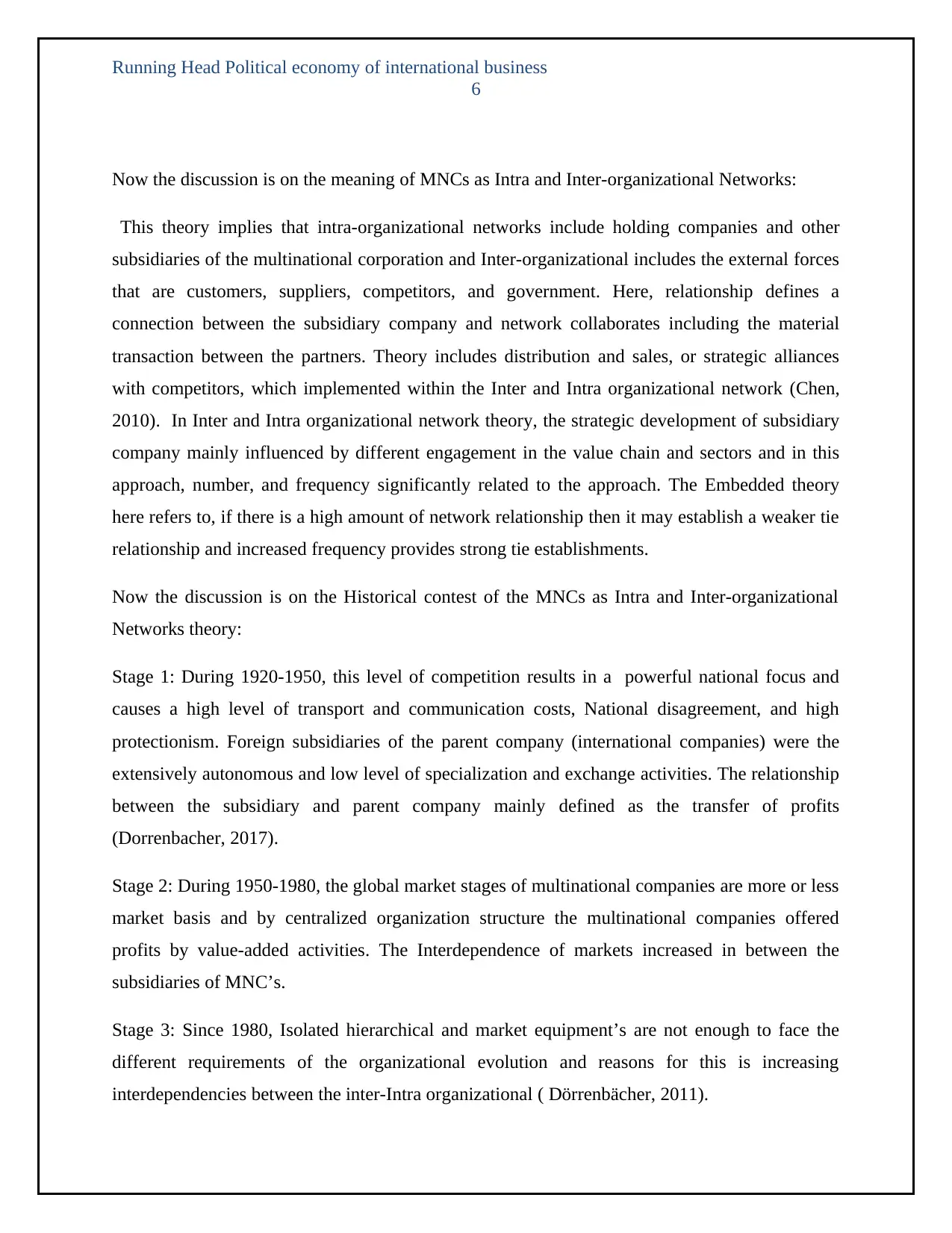
Running Head Political economy of international business
6
Now the discussion is on the meaning of MNCs as Intra and Inter-organizational Networks:
This theory implies that intra-organizational networks include holding companies and other
subsidiaries of the multinational corporation and Inter-organizational includes the external forces
that are customers, suppliers, competitors, and government. Here, relationship defines a
connection between the subsidiary company and network collaborates including the material
transaction between the partners. Theory includes distribution and sales, or strategic alliances
with competitors, which implemented within the Inter and Intra organizational network (Chen,
2010). In Inter and Intra organizational network theory, the strategic development of subsidiary
company mainly influenced by different engagement in the value chain and sectors and in this
approach, number, and frequency significantly related to the approach. The Embedded theory
here refers to, if there is a high amount of network relationship then it may establish a weaker tie
relationship and increased frequency provides strong tie establishments.
Now the discussion is on the Historical contest of the MNCs as Intra and Inter-organizational
Networks theory:
Stage 1: During 1920-1950, this level of competition results in a powerful national focus and
causes a high level of transport and communication costs, National disagreement, and high
protectionism. Foreign subsidiaries of the parent company (international companies) were the
extensively autonomous and low level of specialization and exchange activities. The relationship
between the subsidiary and parent company mainly defined as the transfer of profits
(Dorrenbacher, 2017).
Stage 2: During 1950-1980, the global market stages of multinational companies are more or less
market basis and by centralized organization structure the multinational companies offered
profits by value-added activities. The Interdependence of markets increased in between the
subsidiaries of MNC’s.
Stage 3: Since 1980, Isolated hierarchical and market equipment’s are not enough to face the
different requirements of the organizational evolution and reasons for this is increasing
interdependencies between the inter-Intra organizational ( Dörrenbächer, 2011).
6
Now the discussion is on the meaning of MNCs as Intra and Inter-organizational Networks:
This theory implies that intra-organizational networks include holding companies and other
subsidiaries of the multinational corporation and Inter-organizational includes the external forces
that are customers, suppliers, competitors, and government. Here, relationship defines a
connection between the subsidiary company and network collaborates including the material
transaction between the partners. Theory includes distribution and sales, or strategic alliances
with competitors, which implemented within the Inter and Intra organizational network (Chen,
2010). In Inter and Intra organizational network theory, the strategic development of subsidiary
company mainly influenced by different engagement in the value chain and sectors and in this
approach, number, and frequency significantly related to the approach. The Embedded theory
here refers to, if there is a high amount of network relationship then it may establish a weaker tie
relationship and increased frequency provides strong tie establishments.
Now the discussion is on the Historical contest of the MNCs as Intra and Inter-organizational
Networks theory:
Stage 1: During 1920-1950, this level of competition results in a powerful national focus and
causes a high level of transport and communication costs, National disagreement, and high
protectionism. Foreign subsidiaries of the parent company (international companies) were the
extensively autonomous and low level of specialization and exchange activities. The relationship
between the subsidiary and parent company mainly defined as the transfer of profits
(Dorrenbacher, 2017).
Stage 2: During 1950-1980, the global market stages of multinational companies are more or less
market basis and by centralized organization structure the multinational companies offered
profits by value-added activities. The Interdependence of markets increased in between the
subsidiaries of MNC’s.
Stage 3: Since 1980, Isolated hierarchical and market equipment’s are not enough to face the
different requirements of the organizational evolution and reasons for this is increasing
interdependencies between the inter-Intra organizational ( Dörrenbächer, 2011).
Paraphrase This Document
Need a fresh take? Get an instant paraphrase of this document with our AI Paraphraser
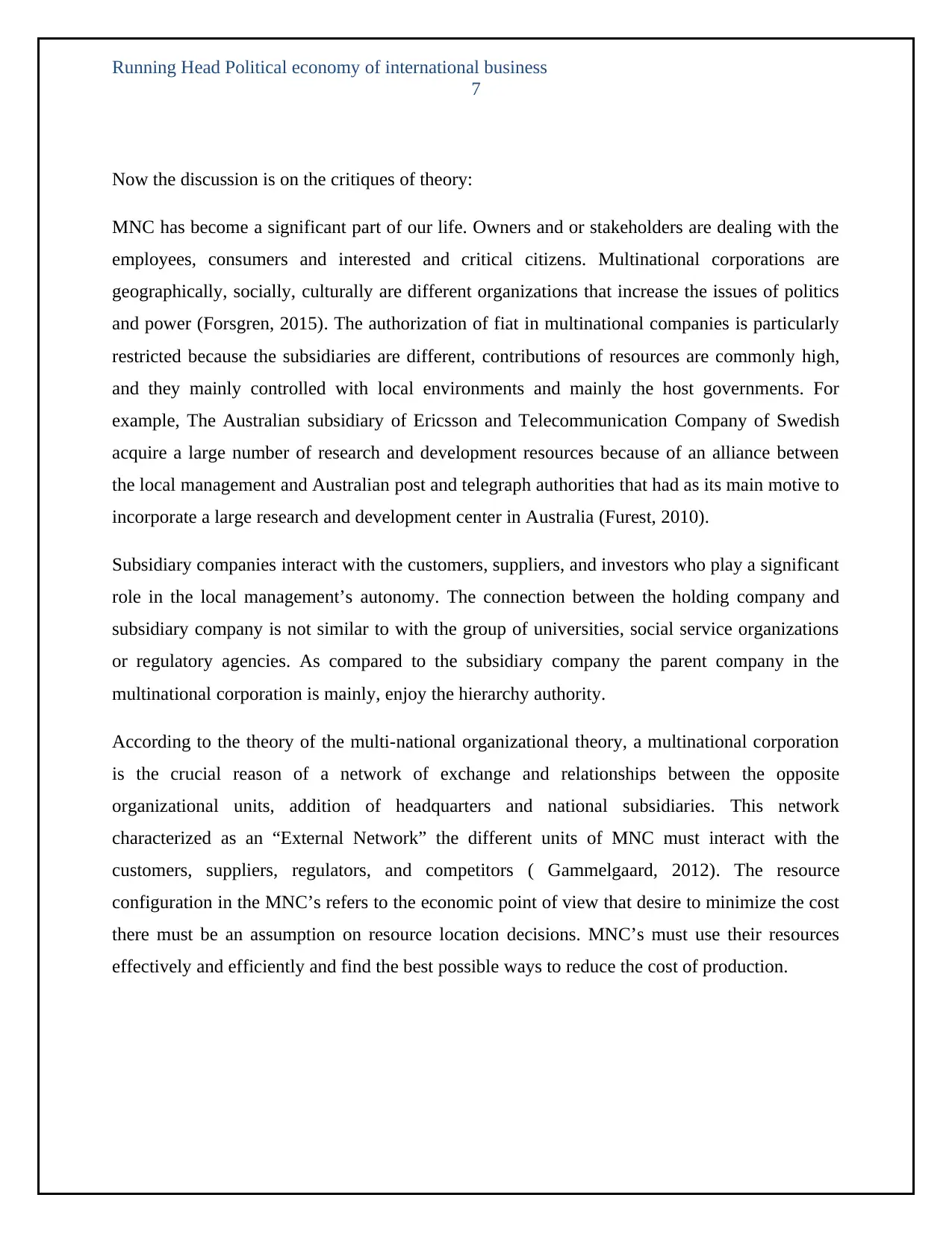
Running Head Political economy of international business
7
Now the discussion is on the critiques of theory:
MNC has become a significant part of our life. Owners and or stakeholders are dealing with the
employees, consumers and interested and critical citizens. Multinational corporations are
geographically, socially, culturally are different organizations that increase the issues of politics
and power (Forsgren, 2015). The authorization of fiat in multinational companies is particularly
restricted because the subsidiaries are different, contributions of resources are commonly high,
and they mainly controlled with local environments and mainly the host governments. For
example, The Australian subsidiary of Ericsson and Telecommunication Company of Swedish
acquire a large number of research and development resources because of an alliance between
the local management and Australian post and telegraph authorities that had as its main motive to
incorporate a large research and development center in Australia (Furest, 2010).
Subsidiary companies interact with the customers, suppliers, and investors who play a significant
role in the local management’s autonomy. The connection between the holding company and
subsidiary company is not similar to with the group of universities, social service organizations
or regulatory agencies. As compared to the subsidiary company the parent company in the
multinational corporation is mainly, enjoy the hierarchy authority.
According to the theory of the multi-national organizational theory, a multinational corporation
is the crucial reason of a network of exchange and relationships between the opposite
organizational units, addition of headquarters and national subsidiaries. This network
characterized as an “External Network” the different units of MNC must interact with the
customers, suppliers, regulators, and competitors ( Gammelgaard, 2012). The resource
configuration in the MNC’s refers to the economic point of view that desire to minimize the cost
there must be an assumption on resource location decisions. MNC’s must use their resources
effectively and efficiently and find the best possible ways to reduce the cost of production.
7
Now the discussion is on the critiques of theory:
MNC has become a significant part of our life. Owners and or stakeholders are dealing with the
employees, consumers and interested and critical citizens. Multinational corporations are
geographically, socially, culturally are different organizations that increase the issues of politics
and power (Forsgren, 2015). The authorization of fiat in multinational companies is particularly
restricted because the subsidiaries are different, contributions of resources are commonly high,
and they mainly controlled with local environments and mainly the host governments. For
example, The Australian subsidiary of Ericsson and Telecommunication Company of Swedish
acquire a large number of research and development resources because of an alliance between
the local management and Australian post and telegraph authorities that had as its main motive to
incorporate a large research and development center in Australia (Furest, 2010).
Subsidiary companies interact with the customers, suppliers, and investors who play a significant
role in the local management’s autonomy. The connection between the holding company and
subsidiary company is not similar to with the group of universities, social service organizations
or regulatory agencies. As compared to the subsidiary company the parent company in the
multinational corporation is mainly, enjoy the hierarchy authority.
According to the theory of the multi-national organizational theory, a multinational corporation
is the crucial reason of a network of exchange and relationships between the opposite
organizational units, addition of headquarters and national subsidiaries. This network
characterized as an “External Network” the different units of MNC must interact with the
customers, suppliers, regulators, and competitors ( Gammelgaard, 2012). The resource
configuration in the MNC’s refers to the economic point of view that desire to minimize the cost
there must be an assumption on resource location decisions. MNC’s must use their resources
effectively and efficiently and find the best possible ways to reduce the cost of production.
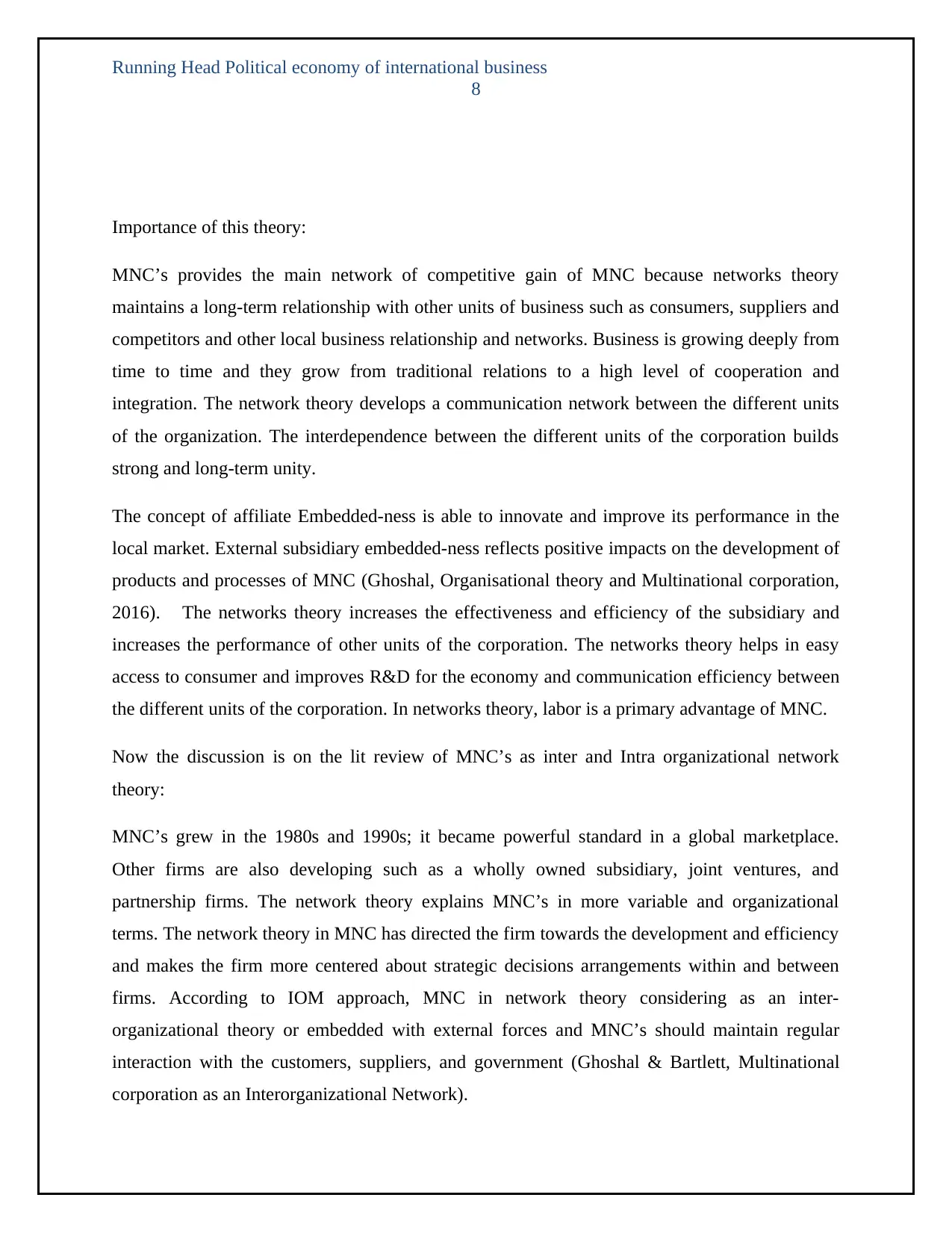
Running Head Political economy of international business
8
Importance of this theory:
MNC’s provides the main network of competitive gain of MNC because networks theory
maintains a long-term relationship with other units of business such as consumers, suppliers and
competitors and other local business relationship and networks. Business is growing deeply from
time to time and they grow from traditional relations to a high level of cooperation and
integration. The network theory develops a communication network between the different units
of the organization. The interdependence between the different units of the corporation builds
strong and long-term unity.
The concept of affiliate Embedded-ness is able to innovate and improve its performance in the
local market. External subsidiary embedded-ness reflects positive impacts on the development of
products and processes of MNC (Ghoshal, Organisational theory and Multinational corporation,
2016). The networks theory increases the effectiveness and efficiency of the subsidiary and
increases the performance of other units of the corporation. The networks theory helps in easy
access to consumer and improves R&D for the economy and communication efficiency between
the different units of the corporation. In networks theory, labor is a primary advantage of MNC.
Now the discussion is on the lit review of MNC’s as inter and Intra organizational network
theory:
MNC’s grew in the 1980s and 1990s; it became powerful standard in a global marketplace.
Other firms are also developing such as a wholly owned subsidiary, joint ventures, and
partnership firms. The network theory explains MNC’s in more variable and organizational
terms. The network theory in MNC has directed the firm towards the development and efficiency
and makes the firm more centered about strategic decisions arrangements within and between
firms. According to IOM approach, MNC in network theory considering as an inter-
organizational theory or embedded with external forces and MNC’s should maintain regular
interaction with the customers, suppliers, and government (Ghoshal & Bartlett, Multinational
corporation as an Interorganizational Network).
8
Importance of this theory:
MNC’s provides the main network of competitive gain of MNC because networks theory
maintains a long-term relationship with other units of business such as consumers, suppliers and
competitors and other local business relationship and networks. Business is growing deeply from
time to time and they grow from traditional relations to a high level of cooperation and
integration. The network theory develops a communication network between the different units
of the organization. The interdependence between the different units of the corporation builds
strong and long-term unity.
The concept of affiliate Embedded-ness is able to innovate and improve its performance in the
local market. External subsidiary embedded-ness reflects positive impacts on the development of
products and processes of MNC (Ghoshal, Organisational theory and Multinational corporation,
2016). The networks theory increases the effectiveness and efficiency of the subsidiary and
increases the performance of other units of the corporation. The networks theory helps in easy
access to consumer and improves R&D for the economy and communication efficiency between
the different units of the corporation. In networks theory, labor is a primary advantage of MNC.
Now the discussion is on the lit review of MNC’s as inter and Intra organizational network
theory:
MNC’s grew in the 1980s and 1990s; it became powerful standard in a global marketplace.
Other firms are also developing such as a wholly owned subsidiary, joint ventures, and
partnership firms. The network theory explains MNC’s in more variable and organizational
terms. The network theory in MNC has directed the firm towards the development and efficiency
and makes the firm more centered about strategic decisions arrangements within and between
firms. According to IOM approach, MNC in network theory considering as an inter-
organizational theory or embedded with external forces and MNC’s should maintain regular
interaction with the customers, suppliers, and government (Ghoshal & Bartlett, Multinational
corporation as an Interorganizational Network).
⊘ This is a preview!⊘
Do you want full access?
Subscribe today to unlock all pages.

Trusted by 1+ million students worldwide
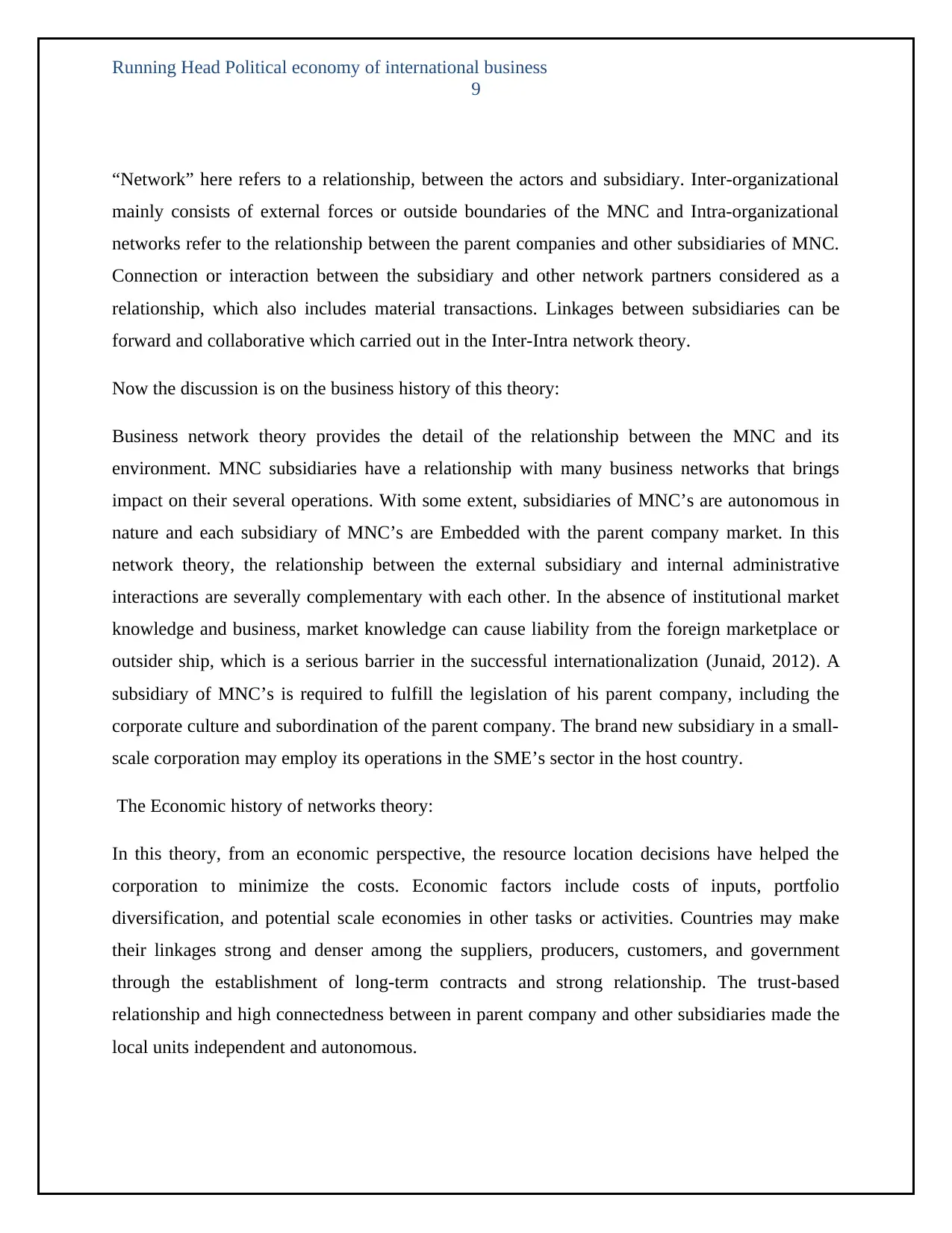
Running Head Political economy of international business
9
“Network” here refers to a relationship, between the actors and subsidiary. Inter-organizational
mainly consists of external forces or outside boundaries of the MNC and Intra-organizational
networks refer to the relationship between the parent companies and other subsidiaries of MNC.
Connection or interaction between the subsidiary and other network partners considered as a
relationship, which also includes material transactions. Linkages between subsidiaries can be
forward and collaborative which carried out in the Inter-Intra network theory.
Now the discussion is on the business history of this theory:
Business network theory provides the detail of the relationship between the MNC and its
environment. MNC subsidiaries have a relationship with many business networks that brings
impact on their several operations. With some extent, subsidiaries of MNC’s are autonomous in
nature and each subsidiary of MNC’s are Embedded with the parent company market. In this
network theory, the relationship between the external subsidiary and internal administrative
interactions are severally complementary with each other. In the absence of institutional market
knowledge and business, market knowledge can cause liability from the foreign marketplace or
outsider ship, which is a serious barrier in the successful internationalization (Junaid, 2012). A
subsidiary of MNC’s is required to fulfill the legislation of his parent company, including the
corporate culture and subordination of the parent company. The brand new subsidiary in a small-
scale corporation may employ its operations in the SME’s sector in the host country.
The Economic history of networks theory:
In this theory, from an economic perspective, the resource location decisions have helped the
corporation to minimize the costs. Economic factors include costs of inputs, portfolio
diversification, and potential scale economies in other tasks or activities. Countries may make
their linkages strong and denser among the suppliers, producers, customers, and government
through the establishment of long-term contracts and strong relationship. The trust-based
relationship and high connectedness between in parent company and other subsidiaries made the
local units independent and autonomous.
9
“Network” here refers to a relationship, between the actors and subsidiary. Inter-organizational
mainly consists of external forces or outside boundaries of the MNC and Intra-organizational
networks refer to the relationship between the parent companies and other subsidiaries of MNC.
Connection or interaction between the subsidiary and other network partners considered as a
relationship, which also includes material transactions. Linkages between subsidiaries can be
forward and collaborative which carried out in the Inter-Intra network theory.
Now the discussion is on the business history of this theory:
Business network theory provides the detail of the relationship between the MNC and its
environment. MNC subsidiaries have a relationship with many business networks that brings
impact on their several operations. With some extent, subsidiaries of MNC’s are autonomous in
nature and each subsidiary of MNC’s are Embedded with the parent company market. In this
network theory, the relationship between the external subsidiary and internal administrative
interactions are severally complementary with each other. In the absence of institutional market
knowledge and business, market knowledge can cause liability from the foreign marketplace or
outsider ship, which is a serious barrier in the successful internationalization (Junaid, 2012). A
subsidiary of MNC’s is required to fulfill the legislation of his parent company, including the
corporate culture and subordination of the parent company. The brand new subsidiary in a small-
scale corporation may employ its operations in the SME’s sector in the host country.
The Economic history of networks theory:
In this theory, from an economic perspective, the resource location decisions have helped the
corporation to minimize the costs. Economic factors include costs of inputs, portfolio
diversification, and potential scale economies in other tasks or activities. Countries may make
their linkages strong and denser among the suppliers, producers, customers, and government
through the establishment of long-term contracts and strong relationship. The trust-based
relationship and high connectedness between in parent company and other subsidiaries made the
local units independent and autonomous.
Paraphrase This Document
Need a fresh take? Get an instant paraphrase of this document with our AI Paraphraser
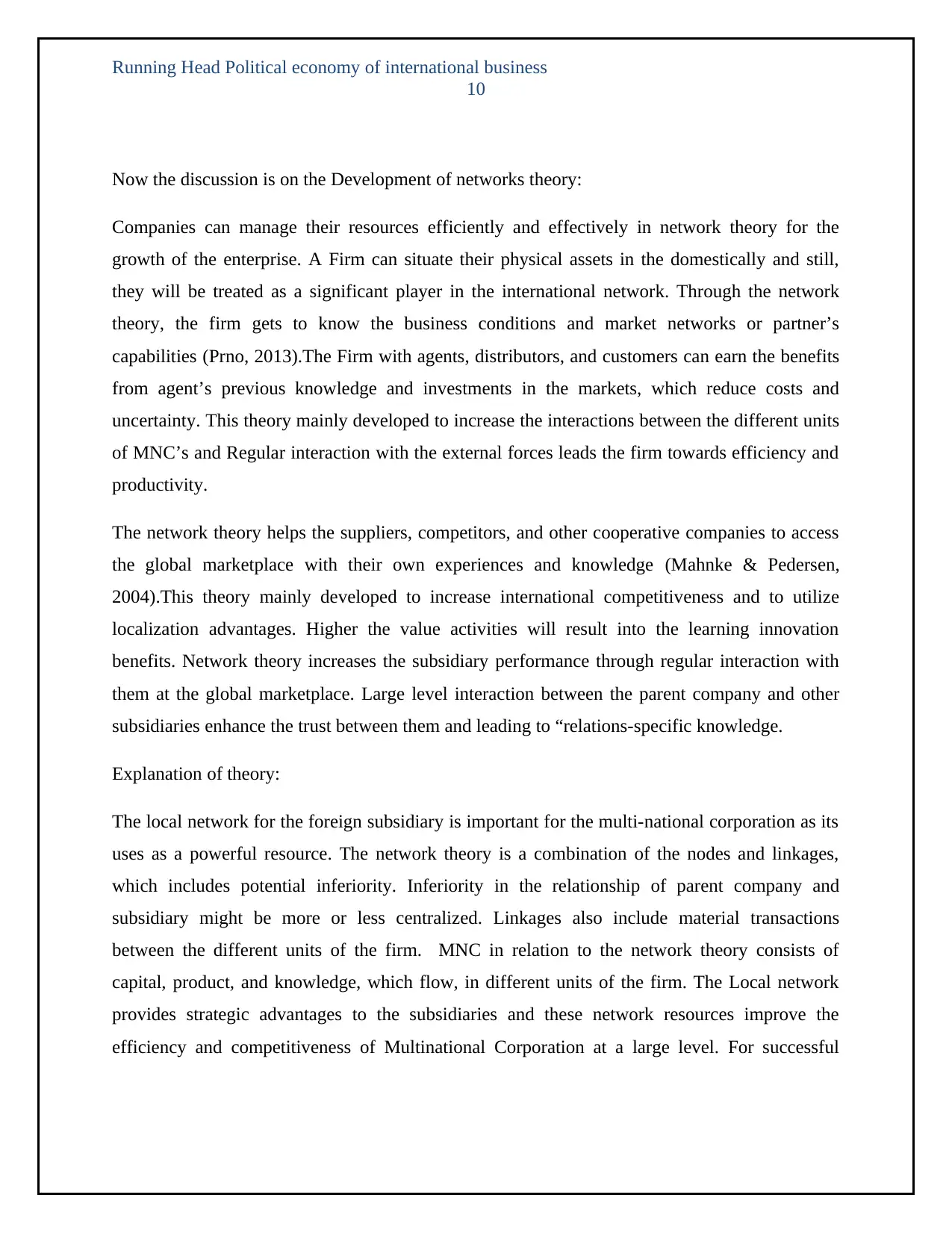
Running Head Political economy of international business
10
Now the discussion is on the Development of networks theory:
Companies can manage their resources efficiently and effectively in network theory for the
growth of the enterprise. A Firm can situate their physical assets in the domestically and still,
they will be treated as a significant player in the international network. Through the network
theory, the firm gets to know the business conditions and market networks or partner’s
capabilities (Prno, 2013).The Firm with agents, distributors, and customers can earn the benefits
from agent’s previous knowledge and investments in the markets, which reduce costs and
uncertainty. This theory mainly developed to increase the interactions between the different units
of MNC’s and Regular interaction with the external forces leads the firm towards efficiency and
productivity.
The network theory helps the suppliers, competitors, and other cooperative companies to access
the global marketplace with their own experiences and knowledge (Mahnke & Pedersen,
2004).This theory mainly developed to increase international competitiveness and to utilize
localization advantages. Higher the value activities will result into the learning innovation
benefits. Network theory increases the subsidiary performance through regular interaction with
them at the global marketplace. Large level interaction between the parent company and other
subsidiaries enhance the trust between them and leading to “relations-specific knowledge.
Explanation of theory:
The local network for the foreign subsidiary is important for the multi-national corporation as its
uses as a powerful resource. The network theory is a combination of the nodes and linkages,
which includes potential inferiority. Inferiority in the relationship of parent company and
subsidiary might be more or less centralized. Linkages also include material transactions
between the different units of the firm. MNC in relation to the network theory consists of
capital, product, and knowledge, which flow, in different units of the firm. The Local network
provides strategic advantages to the subsidiaries and these network resources improve the
efficiency and competitiveness of Multinational Corporation at a large level. For successful
10
Now the discussion is on the Development of networks theory:
Companies can manage their resources efficiently and effectively in network theory for the
growth of the enterprise. A Firm can situate their physical assets in the domestically and still,
they will be treated as a significant player in the international network. Through the network
theory, the firm gets to know the business conditions and market networks or partner’s
capabilities (Prno, 2013).The Firm with agents, distributors, and customers can earn the benefits
from agent’s previous knowledge and investments in the markets, which reduce costs and
uncertainty. This theory mainly developed to increase the interactions between the different units
of MNC’s and Regular interaction with the external forces leads the firm towards efficiency and
productivity.
The network theory helps the suppliers, competitors, and other cooperative companies to access
the global marketplace with their own experiences and knowledge (Mahnke & Pedersen,
2004).This theory mainly developed to increase international competitiveness and to utilize
localization advantages. Higher the value activities will result into the learning innovation
benefits. Network theory increases the subsidiary performance through regular interaction with
them at the global marketplace. Large level interaction between the parent company and other
subsidiaries enhance the trust between them and leading to “relations-specific knowledge.
Explanation of theory:
The local network for the foreign subsidiary is important for the multi-national corporation as its
uses as a powerful resource. The network theory is a combination of the nodes and linkages,
which includes potential inferiority. Inferiority in the relationship of parent company and
subsidiary might be more or less centralized. Linkages also include material transactions
between the different units of the firm. MNC in relation to the network theory consists of
capital, product, and knowledge, which flow, in different units of the firm. The Local network
provides strategic advantages to the subsidiaries and these network resources improve the
efficiency and competitiveness of Multinational Corporation at a large level. For successful
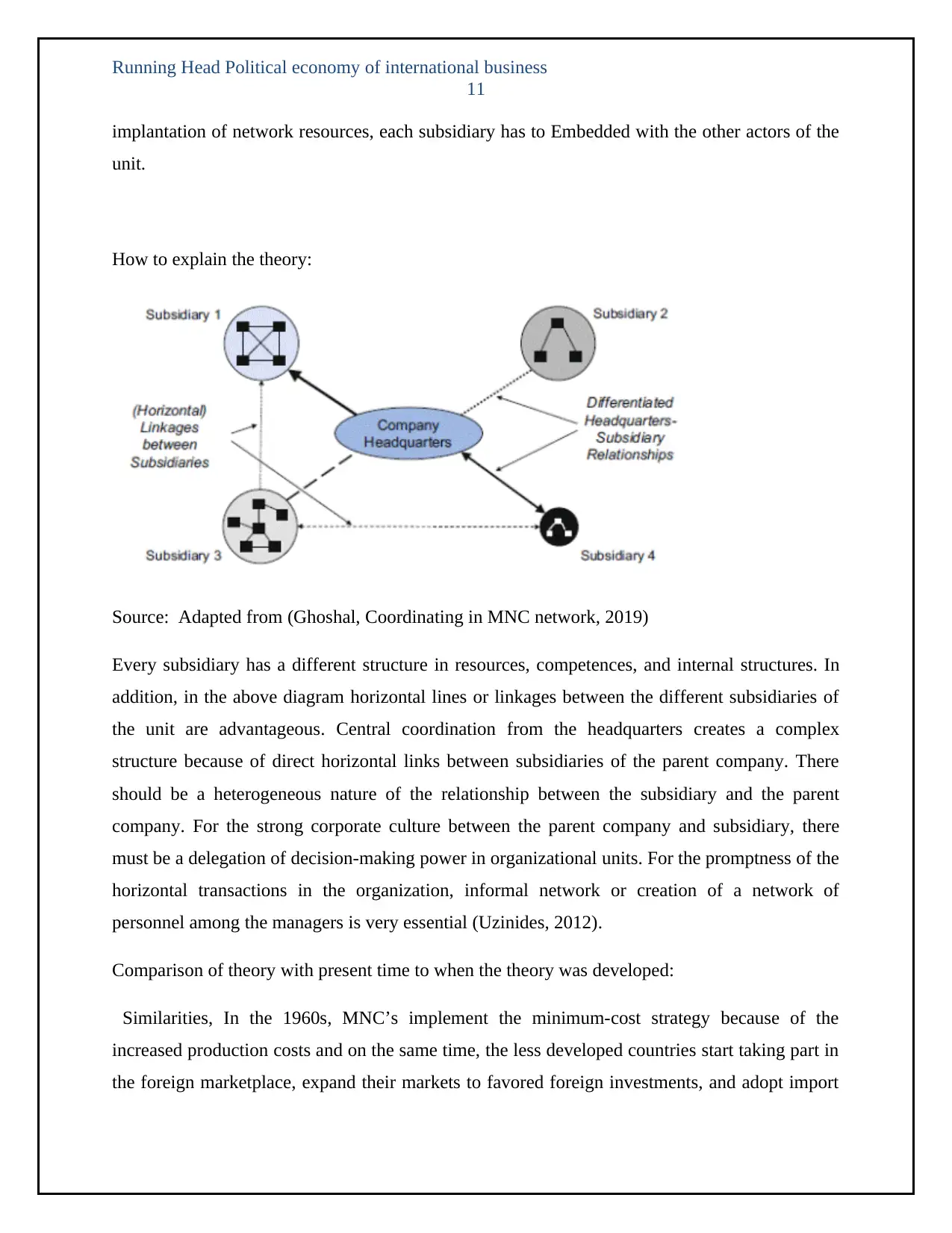
Running Head Political economy of international business
11
implantation of network resources, each subsidiary has to Embedded with the other actors of the
unit.
How to explain the theory:
Source: Adapted from (Ghoshal, Coordinating in MNC network, 2019)
Every subsidiary has a different structure in resources, competences, and internal structures. In
addition, in the above diagram horizontal lines or linkages between the different subsidiaries of
the unit are advantageous. Central coordination from the headquarters creates a complex
structure because of direct horizontal links between subsidiaries of the parent company. There
should be a heterogeneous nature of the relationship between the subsidiary and the parent
company. For the strong corporate culture between the parent company and subsidiary, there
must be a delegation of decision-making power in organizational units. For the promptness of the
horizontal transactions in the organization, informal network or creation of a network of
personnel among the managers is very essential (Uzinides, 2012).
Comparison of theory with present time to when the theory was developed:
Similarities, In the 1960s, MNC’s implement the minimum-cost strategy because of the
increased production costs and on the same time, the less developed countries start taking part in
the foreign marketplace, expand their markets to favored foreign investments, and adopt import
11
implantation of network resources, each subsidiary has to Embedded with the other actors of the
unit.
How to explain the theory:
Source: Adapted from (Ghoshal, Coordinating in MNC network, 2019)
Every subsidiary has a different structure in resources, competences, and internal structures. In
addition, in the above diagram horizontal lines or linkages between the different subsidiaries of
the unit are advantageous. Central coordination from the headquarters creates a complex
structure because of direct horizontal links between subsidiaries of the parent company. There
should be a heterogeneous nature of the relationship between the subsidiary and the parent
company. For the strong corporate culture between the parent company and subsidiary, there
must be a delegation of decision-making power in organizational units. For the promptness of the
horizontal transactions in the organization, informal network or creation of a network of
personnel among the managers is very essential (Uzinides, 2012).
Comparison of theory with present time to when the theory was developed:
Similarities, In the 1960s, MNC’s implement the minimum-cost strategy because of the
increased production costs and on the same time, the less developed countries start taking part in
the foreign marketplace, expand their markets to favored foreign investments, and adopt import
⊘ This is a preview!⊘
Do you want full access?
Subscribe today to unlock all pages.

Trusted by 1+ million students worldwide
1 out of 18
Related Documents
Your All-in-One AI-Powered Toolkit for Academic Success.
+13062052269
info@desklib.com
Available 24*7 on WhatsApp / Email
![[object Object]](/_next/static/media/star-bottom.7253800d.svg)
Unlock your academic potential
Copyright © 2020–2025 A2Z Services. All Rights Reserved. Developed and managed by ZUCOL.





